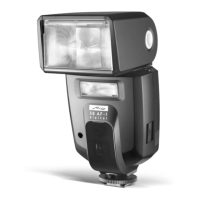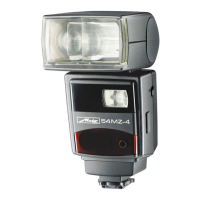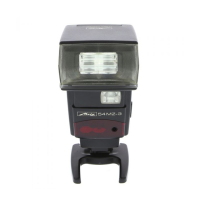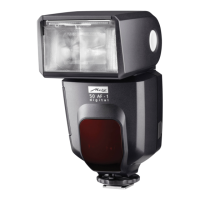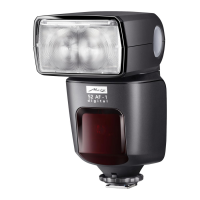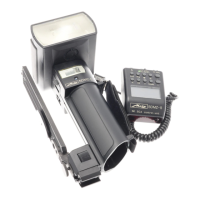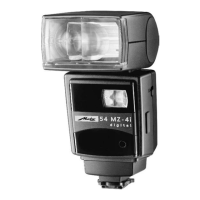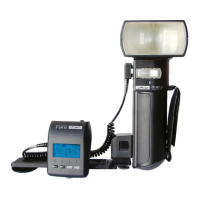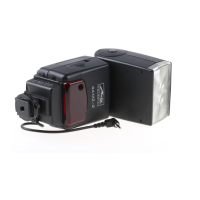Do you have a question about the Metz MECABLITZ 58 AF-2 digital and is the answer not in the manual?
Protect from water, heat, humidity. Avoid covering reflector screen.
Do not disassemble, avoid battery issues, manage heat overload.
Flash functions are adapted to camera types, categorized into groups A-E.
Lists specific flash functions available for different camera groups.
Attaching the flash unit and handling batteries.
Instructions for turning the flash unit on and off.
Connecting an optional power pack for extended use.
Overview of supported flash modes: TTL, A, M, Stroboscope.
Step-by-step guide to select and set flash modes via the menu.
Details on advanced TTL modes for specific camera groups.
Description of fill-in flash for balanced exposure with daylight.
Procedure to set the TTL BL flash mode for fill-in lighting.
How the auto mode measures light and adjusts flash output.
Steps to select and configure the automatic flash mode.
Using manual mode for full light output and partial adjustments.
Using strobe mode for multiple flashes on a single photo.
Adjusting flash frequency and number of flashes for strobe mode.
Reducing partial light output for shorter flashes in strobe mode.
Available parameters: N, f, P, F, Zoom, EV, ISO.
Procedure for manually setting parameters when no data transfer occurs.
Manually setting reflector position for non-CPU lenses or specific effects.
Automatic adjustment of reflector position with CPU lenses.
Adjusting exposure compensation for bright/dark backgrounds.
Manually setting ISO for non-CPU lenses or specific modes.
How to access and select special functions via the menu.
Enabling acoustic signals for flash readiness and exposure confirmation.
Setting the beep function on/off and its behavior.
Performing flash bracketing with varying exposure correction values.
Reducing reflector focal length for wider light coverage.
Notes on flash bracketing support in TTL and Auto modes.
Adjusting light angle to match camera chip format (e.g., APS-C).
Setting up Master/Slave or OFF for wireless remote control.
Switching distance display between meters and feet.
Adjusting the secondary reflector's output for frontal fill-in lighting.
Using the modelling light to preview lighting and shadows.
Flash unit automatically enters standby to save power.
Setting standby time intervals or deactivating the function.
Locking buttons to prevent accidental presses.
Turning the AF-beam assist light on or off.
Manually setting zoom positions for specific lenses.
Using the wide-angle diffuser for 12mm+ focal lengths.
Using the secondary reflector for bounce lighting.
Compensating for parallax error in macro shots with reflector tilt.
Understanding the flash ready symbol and its meaning.
How the camera and flash sync at appropriate shutter speeds.
Interpreting the "OK" indicator for correct exposure.
Understanding warnings for underexposure in TTL mode.
Signals in the viewfinder indicating flash status and readiness.
Understanding the maximum flash range displayed.
Adjusting flash range when using Group A cameras.
Handling FEE errors and guide numbers with non-CPU lenses.
Storing metering results for precise exposure control.
Syncing flash to the second curtain for motion trails.
Using slow shutter speeds to emphasize background in low light.
Using faster shutter speeds with flash.
Using a preflash to reduce red-eye effects.
Using the AF beam for focusing in low light.
System compatibility for wireless remote control.
Setting the flash unit as Master, Slave, or OFF.
Setting groups, channels, and zoom for master operation.
Setting remote channel and zoom on slave units.
Performing test flashes to verify remote setup.
Using servo mode for slave operation triggered by a light pulse.
Adjusting partial lighting or reflector position in Servo mode.
Turning off the servo flash mode.
Updating firmware and resetting to factory settings.
Procedure to form the flash capacitor after prolonged storage.
Issues with AF beam activation and zoom position adjustment.
Issues with TTL sync, remote operation, and manual correction.
Problems with sync speed, shadows, and range.
Problems adjusting ISO and aperture values.
Product manufactured with recyclable materials.
Indicates WEEE symbol and proper disposal methods.
Information regarding CE approval and electromagnetic compatibility.
Statement reserving rights for technical changes and errors.
| Flash Modes | TTL, Manual, Multi |
|---|---|
| Zoom Range | 24-105 mm |
| Auto Zoom Head | Yes |
| Bounce Head | Yes |
| Swivel Head | Yes |
| Power Source | 4 x AA batteries |
| Guide Number | 58 |
| Flash Type | TTL |
| Swivel Angle | 180° |
| Weight | 400 g |
| Compatibility | Canon, Nikon, Sony, Pentax, Olympus, Panasonic |
| Coverage | 24-105mm |

